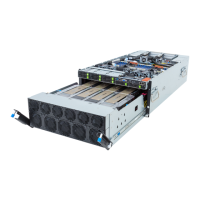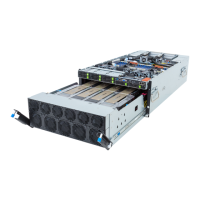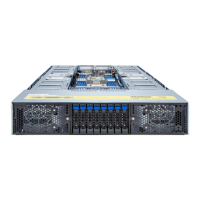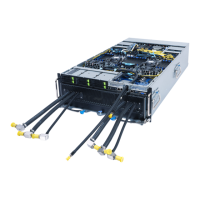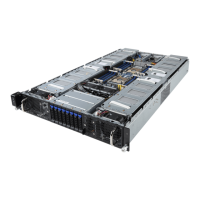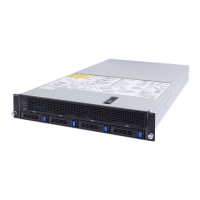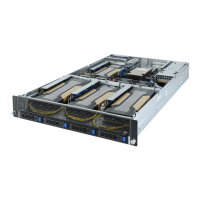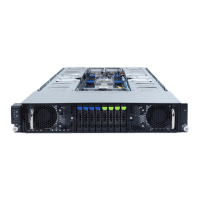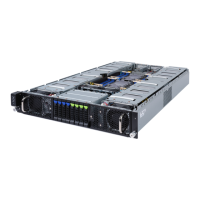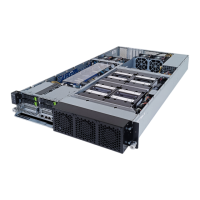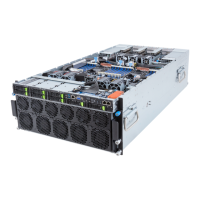
Do you have a question about the Gigabyte G593-SD0-AAX1 and is the answer not in the manual?
Guidelines for safe and proper installation to prevent damage and injury.
Details on the server's hardware components, dimensions, and capabilities.
Visual representation of the system's interconnected components and data flow.
Diagram illustrating PCIe device connections and data paths within the system.
Identification and description of components and indicators on the front of the server.
Identification and description of components and ports on the rear of the server.
Detailed explanation of front panel indicators and their states.
Explains the behavior of Root of Trust (RoT) LEDs during authentication processes.
Description of LED indicators for system LAN ports and their meanings.
Explanation of the status LEDs for the power supply unit.
Details on LED indicators for hard disk drives and their status.
General safety and ESD precautions before starting hardware installation.
Procedures for removing and installing the server's top cover.
Instructions for safely removing and installing the GPU tray assembly.
Procedures for removing and reinstalling the CPU heatsink.
Detailed steps for correctly installing a CPU onto the motherboard.
Guidelines and procedures for installing DDR5 memory modules.
Instructions for installing PCI expansion cards into the server.
Guide for installing 2.5" hard disk drives into the server.
Procedures for replacing system fan modules.
Steps for removing and installing the server's power supply units.
Instructions for safely removing the server from its rack cabinet.
Diagrams and descriptions for connecting various internal cables.
Detailed identification of various connectors and components on the motherboard.
Configuration options using jumpers on the motherboard.
Description of the G-SC module and its connectors.
Identification of storage connectors on the backplane board.
Overview of the BIOS setup program's main interface and navigation.
Options for configuring advanced hardware component functions in BIOS.
Configuration for Trusted Computing features, including TPM support.
Settings for managing the system remotely via serial port console redirection.
Configuration settings for the Super I/O chip and its logical devices.
Options for configuring PCI subsystem settings, including I/O ROM and lanes.
Settings for USB controllers, hand-off, and emulation.
Configuration options for the UEFI network stack and PXE/HTTP support.
Settings for POST error reporting and system halt behavior.
Configuration options for NVMe devices and OPROM selection.
Settings related to chipset behavior, such as AC power loss resume and chassis intrusion.
Configuration for TLS authentication settings, including server and client certificates.
Settings for iSCSI initiator configuration and attempt priority.
Configuration options for the Intel X710 10GbE network controller.
Settings for configuring Virtual LAN (VLAN) IDs and priorities.
Displays the health status of installed device drivers and controllers.
Submenu for configuring Platform Controller Hub (PCH) functions.
Detailed settings for processor features, pre-socket configuration, and performance tuning.
Settings for Non-Uniform Memory Access (NUMA) and virtual NUMA configuration.
Configuration for the UPI (Ultra Path Interconnect) link and cluster functions.
Settings for memory frequency, ADR, memory topology, and RAS configurations.
Configuration for Intel VT for Directed I/O (VT-d) and other I/O device settings.
Settings for CPU power states, P-states, and advanced power management tuning.
Configuration for SATA controllers, RST, and RAID modes.
Settings for active video selection and external spread spectrum.
Displays status and information for the Management Engine (ME) firmware.
Configuration for system, software, memory, and PCIe error logging.
Settings for selecting power policy quick settings and managing CPU power states.
Menu for managing server functions like FRB-2 timer, OS watchdog, and BMC settings.
Configuration for enabling/disabling System Event Logging and managing SEL entries.
Displays basic system ID and product information (FRU).
Settings for configuring BMC VLAN ID and priority.
Configuration of BMC network settings, including IP address and MAC address.
Settings for configuring IPv6 network parameters for the BMC.
Options for setting administrator and user passwords to protect system access.
Configuration for Secure Boot features to ensure system integrity during startup.
Settings for controlling the system's boot order and behavior.
Options for saving BIOS settings or discarding changes and exiting the setup.
Instructions for recovering the BIOS in case of corruption.
Reference for beep codes indicating POST status or errors.
